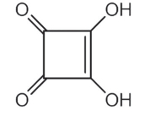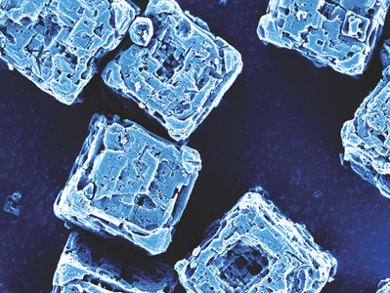Materials made from porous carbon have many potential applications, e.g, in electrochemistry, energy storage, catalysis, and gas storage and separation. Hierarchically structured carbon materials have shown especially high performance, but their synthesis usually involves templating, which is time-consuming and expensive.
Nina Fechler and colleagues, Max Planck Institute of Colloids and Interfaces, Potsdam, Germany, have developed a template-free synthesis of hierarchically porous carbon cubes (pictured above). They use a one-pot approach involving the complexation of squaric acid (pictured below) as the carbon precursor with zinc ions, which gives porous, crystalline cubes. Heat treatment of these crystals at at 900 °C gives zinc oxide-carbon composites, and the researchers then washed the crystals with acid to generate the desired porous carbon structures.

The resulting hierarchically porous carbon cubes have high surface areas (1295 m2/g) and large pore volumes (1.5 cm3/g) and retain the structure of the initial crystals. The researchers show that the materials are promising electrode materials for supercapacitor applications with a specific capacitance of 133 F/g in H2SO4 at a scan rate of 5 mV/s. 67 % of this specific capacitance is retained when the scan rate is increased to 200 mV/s.
According to the team, this method can also be extended to other geometries, which allows rational carbon structuring, and thus targeted design for applications such as energy storage devices.
- “Cubism” on the Nanoscale: From Squaric Acid to Porous Carbon Cubes,
Christian Mbaya Mani, Thomas Berthold, Nina Fechler,
Small 2016.
DOI: 10.1002/smll.201600284




